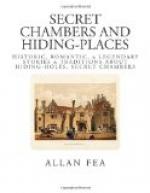The fugitives found temporary security at another recusant house a few miles from Scotney, possibly the old half-timber house of Twissenden, where a secret chapel and adjacent “priests’ holes” are still pointed out.
The original manuscript account of the search at Scotney was written by one of the Darrell family, who was in the castle at the time of the events recorded.[1]
[Footnote 1: See Morris’s Troubles of our Catholic Forefathers.]
CHAPTER V
HARVINGTON, UFTON, AND INGATESTONE
We will now go in search of some of the most curious hiding-places in existence. There are numerous known examples all over the country, and perhaps as many again exist, which will preserve their secret for ever. For more than three hundred years they have remained buried, and unless some accident reveals their locked-up mysteries, they will crumble away with the walls which contain them; unless, indeed, fire, the doom of so many of our ancestral halls, reduces them to ashes and swallows up the weird stories they might have told. In many cases not until an ancient building is pulled down are such strange discoveries made; but, alas! there are as many instances where structural alterations have wantonly destroyed these interesting historical landmarks.
[Illustration: ENTRANCE TO “PRIEST’S HOLE,” HARVINGTON HALL]
[Illustration: HARVINGTON HALL, WORCESTERSHIRE]
Unaccounted-for spaces, when detected, are readily utilised. Passages are bodily run through the heart of many a secret device, with little veneration for the mechanical ingenuity that has been displayed in their construction. The builder of to-day, as a rule, knows nothing of and cares less, for such things, and so they are swept away without a thought. To such vandals we can only emphasise the remarks we have already made about the market value of a “priest-hole” nowadays.
A little to the right of the Kidderminster road, and about two miles from the pretty village of Chaddesley Corbet, with its old timber houses and inn, stands the ghostly old hall of Harvington. The ancient red-brick pile rises out of its reed-grown moat with that air of mystery which age and seeming neglect only can impart. Coming upon it unexpectedly, especially towards dusk, one is struck with the strange, dignified melancholy pervading it. Surely Hood’s Haunted House or Poe’s House of Usher stands before us, and we cannot get away from the impression that a mystery is wrapped within its walls. Harvington Hall dates from the reign of Henry VIII., but it has undergone various changes, so it is difficult to affix any particular period or style to its architecture; indeed, it is this medley of different styles which forms such a poetically picturesque outline. In its day Harvington could doubtless hold its own with the finest mansions in the country, but now it is forgotten, deserted, and crumbling to pieces. Its very history appears to be lost to the world, as those who go to the county histories and general topographical works for information will find.




